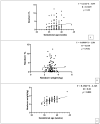Parental Genetics Communicate with Intrauterine Environment to Reprogram Newborn Telomeres and Immunity
- PMID: 36497039
- PMCID: PMC9735452
- DOI: 10.3390/cells11233777
Parental Genetics Communicate with Intrauterine Environment to Reprogram Newborn Telomeres and Immunity
Abstract
Telomeres, markers for cellular senescence, have been found substantially influenced by parental inheritance. It is well known that genomic stability is preserved by the DNA repair mechanism through telomerase. This study aimed to determine the association between parents−newborn telomere length (TL) and telomerase gene (TERT), highlighting DNA repair combined with TL/TERT polymorphism and immunosenescence of the triad. The mother−father−newborn triad blood samples (n = 312) were collected from Ziauddin Hospitals, Pakistan, between September 2021 and June 2022. The telomere length (T/S ratio) was quantified by qPCR, polymorphism was identified by Sanger sequencing, and immunosenescence by flow cytometry. The linear regression was applied to TL and gene association. The newborns had longest TL (2.51 ± 2.87) and strong positive association (R = 0.25, p ≤ 0.0001) (transgenerational health effects) with mothers’ TL (1.6 ± 2.00). Maternal demographics—socioeconomic status, education, and occupation—showed significant effects on TL of newborns (p < 0.015, 0.034, 0.04, respectively). The TERT risk genotype CC (rs2736100) was predominant in the triad (0.6, 0.5, 0.65, respectively) with a strong positive association with newborn TL (β = 2.91, <0.0011). Further analysis highlighted the expression of KLRG 1+ in T-cells with shorter TL but less frequent among newborns. The study concludes that TERT, parental TL, antenatal maternal health, and immunity have a significantly positive effect on the repair of newborn TL.
Keywords: DNA repair; TERT; immunity; polymorphism; reprogramming; telomerase; telomere; telomere length (TL).
Conflict of interest statement
The authors declare no conflict of interest.
Figures








Similar articles
-
Identification of polymorphic alleles in TERC and TERT gene reprogramming the telomeres of newborn and legacy with parental health.Saudi J Biol Sci. 2024 Feb;31(2):103897. doi: 10.1016/j.sjbs.2023.103897. Epub 2023 Dec 12. Saudi J Biol Sci. 2024. PMID: 38192544 Free PMC article.
-
Involvement of Inheritance in Determining Telomere Length beyond Environmental and Lifestyle Factors.Aging Dis. 2023 Nov 5;15(6):2470-2490. doi: 10.14336/AD.2023.1023. Aging Dis. 2023. PMID: 37962459 Free PMC article. Review.
-
Maternal overweight but not paternal overweight before pregnancy is associated with shorter newborn telomere length: evidence from Guangxi Zhuang birth cohort in China.BMC Pregnancy Childbirth. 2021 Apr 9;21(1):283. doi: 10.1186/s12884-021-03757-x. BMC Pregnancy Childbirth. 2021. PMID: 33836691 Free PMC article.
-
Peripartum depression symptom trajectories, telomere length and genotype, and adverse childhood experiences.BMC Psychiatry. 2024 Oct 8;24(1):661. doi: 10.1186/s12888-024-06115-1. BMC Psychiatry. 2024. PMID: 39379870 Free PMC article.
-
Maternal psychological stress during pregnancy and newborn telomere length: a systematic review and meta-analysis.BMC Psychiatry. 2023 Dec 15;23(1):947. doi: 10.1186/s12888-023-05387-3. BMC Psychiatry. 2023. PMID: 38102621 Free PMC article.
Cited by
-
Identification of polymorphic alleles in TERC and TERT gene reprogramming the telomeres of newborn and legacy with parental health.Saudi J Biol Sci. 2024 Feb;31(2):103897. doi: 10.1016/j.sjbs.2023.103897. Epub 2023 Dec 12. Saudi J Biol Sci. 2024. PMID: 38192544 Free PMC article.
-
From premature birth to premature kidney disease: does accelerated aging play a role?Pediatr Nephrol. 2024 Jul;39(7):2001-2013. doi: 10.1007/s00467-023-06208-1. Epub 2023 Nov 10. Pediatr Nephrol. 2024. PMID: 37947901 Free PMC article. Review.
-
Involvement of Inheritance in Determining Telomere Length beyond Environmental and Lifestyle Factors.Aging Dis. 2023 Nov 5;15(6):2470-2490. doi: 10.14336/AD.2023.1023. Aging Dis. 2023. PMID: 37962459 Free PMC article. Review.
-
Parental telomeres implications on immune senescence of newborns.Am J Clin Exp Immunol. 2023 Oct 15;12(5):81-86. eCollection 2023. Am J Clin Exp Immunol. 2023. PMID: 38022874 Free PMC article.
References
-
- Stella G.M., Balestro E., Lacedonia D., Baraldo S. Telomeropathies: An emerging spectrum of disorders with important implications for patients with interstitial lung disease. Minerva Medica. 2016;107:9–14. - PubMed
-
- Adler N., Pantell M.S., O’Donovan A., Blackburn E., Cawthon R., Koster A., Opresko P., Newman A., Harris T.B., Epel E. Educational attainment and late life telomere length in the Health, Aging and Body Composition Study. Brain. Behav. Immun. 2013;27:15–21. doi: 10.1016/j.bbi.2012.08.014. - DOI - PMC - PubMed
MeSH terms
Substances
Grants and funding
LinkOut - more resources
Full Text Sources

